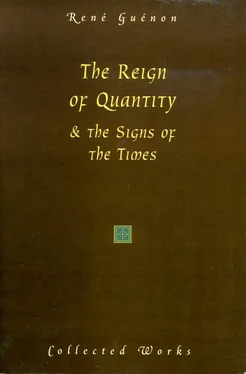These words translate in a rather unsatisfactory way the Greek terms εἶδος and ὕλη employed in the same sense by Aristotle. These terms will be referred to again later.
It is possible to speak of Brahma saguna or ‘qualified’, but there can be no possible question of Brahma ‘quantified’.
It may be observed that the name of a being, insofar as it is an expression of its essence, is properly speaking a number understood in this qualitative sense; and this establishes a close link between the conception of the Pythagorean numbers — and consequently that of the Platonic ideas —and the use of the Sanskrit word nāma to denote the essential side of a being.
It must be pointed out, in connection with essence and substance, that the scholastics often translate as substantia the Greek word οὐσία, which on the contrary means properly and literally ‘essence’, and this contributes not a little to the growth of linguistic confusion; hence such expressions as ‘substantial form’ for instance, this expression being very ill adapted to convey the idea of that which really constitutes the essential side of a being and not its substantial side.
The primary meaning of the word ὕλη is related to the vegetative principle; here there is an allusion to the ‘root’ (in Sanskrit mūla , a term applied to Prakriti) which is the starting-point of manifestation; in this can be seen some connection which does in fact plunge its roots into that which constitutes the obscure support of our world, substance indeed being in a way the tenebrous pole of existence, as will appear more clearly later on.
The pure idea of number is essentially that of whole number, and it is evident that the sequence of the whole numbers constitutes a discontinuous series; all the extensions that have been applied to this idea, and that have given rise to the notions of fractional numbers and incommensurable numbers, are real alterations, and only in fact represent the efforts that have been made to reduce as far as possible the intervals in the numerical discontinuity, so as to lessen the imperfection inherent in the application of number to continuous magnitudes.
This also agrees well with the original meaning of the word ὕλη which was given above: the plant is so to speak the ‘mother’ of the fruit that comes forth from it and is nourished from its substance, but the fruit is only developed and ripened under the vivifying influence of the sun, the sun being thus in a sense its ‘father’; and as a result the fruit itself is symbolically assimilated to the sun by ‘co-essentiality’, if it be permissible to use this expression, as may also be understood by reference to explanations given elsewhere of the symbolism of the Ādityas and other similar traditional notions.
These two terms, ‘intelligible’ and ‘sensible’, used in this way as correlatives, properly belong to the language of Plato; it is well known that the ‘intelligible world’ is for Plato the domain of ‘ideas’ or of ‘archetypes’, which, as we have seen, are actually essences in the proper sense of the word; and, in relation to this intelligible world, the sensible world, which is the domain of corporeal elements and proceeds from their combinations, is situated on the substantial side of manifestation.
‘Notes on the Kaṭa Upaniṣad,’ New Indian Antiquary (Bombay) 470 (1938): pt. 2.
The Sanskrit word rita is related by its root to the Latin ordo , and it is scarcely necessary to point out that it is related even more closely to the word ‘rite’: a rite is, etymologically, that which is accomplished in conformity with ‘order’, and which consequently imitates or reproduces at its own level the very process of manifestation; and that is why, in a strictly traditional civilization, every act of whatever kind takes on an essentially ritual character.
Cf. A. K. Coomaraswamy, ibid.
Cf. Man and His Becoming according to the Vedanta , chap. 17.
Cf. The Symbolism of the Cross , chap. 4.
Omnia in mensura , numero et pondere disposuisti (Wisd. of Sol. 11:20).
In Arabic, the word hindesah , of which the primary meaning is ‘measure’, serves to denote both geometry and architecture, the latter being really an application of the former.
Coomaraswamy has called attention to a curious symbolical drawing by William Blake representing the ‘Ancient of Days’, appearing in the solar orb, whence he points toward the outside a compass held in his hand, all of which might illustrate the following words from the Rg-Veda (VIII.25.18): ‘With his ray he hath measured [or determined] the bounds of Heaven and of Earth’ (and among the symbols of certain Masonic grades is found a compass, the head of which is formed of a sun with rays). Here it is a case of the figuration of that aspect of the Principle that Western initiations call the ‘Great Architect of the Universe’, who becomes too in certain cases the ‘Great Geometrician of the Universe’, and who is identical with Vishvakarma of the Hindu tradition, the ‘Spirit of Universal Construction’; his terrestrial representatives, that is to say those who in some way ‘incarnate’ this Spirit in the case of each distinct traditional form, are what has earlier been called, for this very reason, the ‘Great Architects of the Orient and of the Occident’.
It is true that Descartes, at the beginning of his physics, only claims to construct a hypothetical world on the basis of certain assumptions, which can be reduced to extension and movement; but, since he is at pains to demonstrate later that the phenomena that would be produced in such a world are precisely those of which we are aware in our own, it is clear that, in spite of his purely verbal precaution, he intends to conclude that our world is in fact constituted like the world he began by imagining.
This argument is equally applicable against atomism, which by definition admits no positive existence other than that of atoms and their combinations, and is thus necessarily led to posit a void between the atoms for them to move about in.
Such are, for instance, descriptive geometry, and the geometry to which certain mathematicians have given the name of analysis situs .
This is just what Leibnitz expressed by the formula: Aequalia sunt ejusdem quantitatis ; similia sunt ejusdem qualitatis .
For a full treatment of this theme, reference may be made to the considerations set out, and fully developed, in The Symbolism of the Cross .
Attention may be directed in particular to all questions of ritual related to ‘orientation’; this cannot be dwelt on here, and it need only be mentioned that not only are the conditions for the construction of buildings traditionally determined in this way, whether they be temples or houses, but also those for the foundation of cities. The orientation of churches is the last vestige of this that has persisted in the West up to the beginning of modern times, the last vestige, at least, from an ‘exterior’ point of view, for within the symbolism of initiatic forms considerations of this order, though not generally understood today, have always kept their place, even when the present degenerate condition of affairs has led to a belief that the maintenance of the effective realization of the implied conditions can be dispensed with, and that a purely ‘speculative’ representation of them is enough.
Читать дальше











